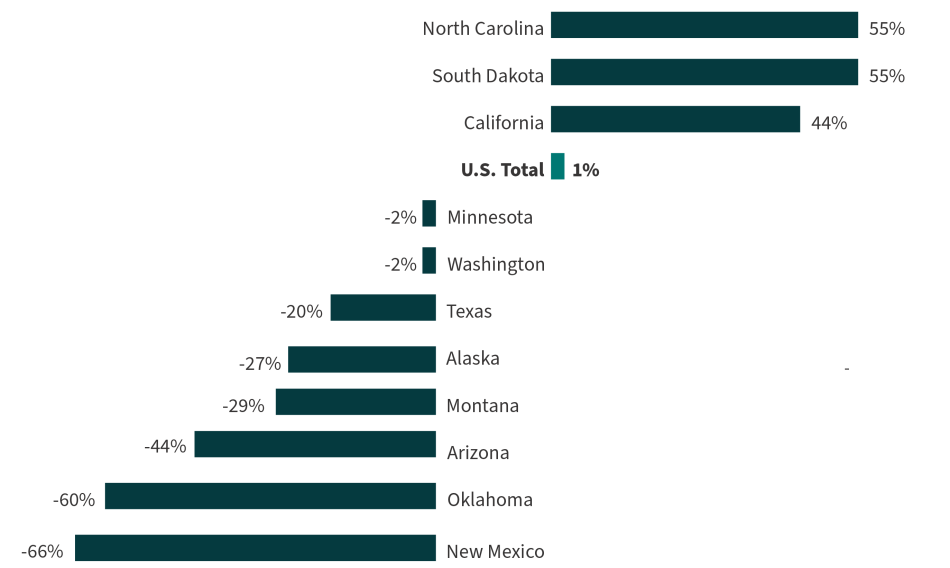Tribal Disparities in Youth Incarceration
Disparities in tribal youth incarceration have grown worse over the course of the decade, with tribal youth being more than three times as likely to be incarcerated than their white peers.
Related to: Youth Justice, Racial Justice
For a decade, incarceration disparities between Tribal and white youth have remained stubbornly high. As of 2021, Tribal youth were 3.7 times as likely to be detained or committed in juvenile facilities as their white peers, according to nationwide data collected in October 2021 and recently released. This ratio is essentially unchanged from 2011.1
There are 11 states with at least 8,000 Tribal youths (a cutoff that allows for meaningful comparisons), and Tribal youth are more likely than their white peers to be in custody in eight of these states. For the purposes of this fact sheet, all “Tribal youth” are by definition non-Hispanic/Latinx. (The underlying dataset labels them as American Indian2.)
Juvenile facilities, including 1,323 detention centers, residential treatment centers, group homes, and youth prisons3 held 24,894 youths as of October 2021. These data do not include the 291 people under 18 in adult prisons at year-end 20214 or the estimated 2,000 people under 18 in adult jails at midyear 2021.5
Nationally, the youth placement rate was 74 per 100,000 in 2021. The Tribal youth placement rate was 181 per 100,000, compared to the white youth placement rate of 49 per 100,000.
Between 2011 and 2021, overall juvenile placements fell 59%. In the 11 states with at least 8,000 Tribal youths between the ages of 10 and 17, between 2011 and 2021, disparities grew by at least 50% in two and decreased by at least 50% in two.
- As of 2021, in Minnesota, South Dakota and North Carolina, Tribal youth are at least five times as likely to be held in placement as white youth.
- Between 2011 and 2021, New Mexico and Oklahoma saw their Tribal/white disparity decrease by at least 50%.
- During these same years, North Carolina and South Dakota saw their Tribal/white disparity increase by at least 50%.
| State | Tribal Rate | White Rate | T/W Disparity |
|---|---|---|---|
| Alaska | 412 | 147 | 2.8 |
| Arizona | 48 | 41 | 1.2 |
| California | 119 | 32 | 3.7 |
| Minnesota | 627 | 33 | 19.0 |
| Montana | 200 | 62 | 3.2 |
| New Mexico | 87 | 193 | 0.5 |
| North Carolina | 96 | 16 | 6.0 |
| Oklahoma | 34 | 46 | 0.7 |
| South Dakota | 358 | 42 | 8.5 |
| Texas | 39 | 60 | 0.7 |
| Washington | 170 | 35 | 4.9 |
| U.S. Total | 181 | 49 | 3.7 |
The table above and the following figure are limited to the 11 states with at least 8,000 non-Hispanic Tribal residents between 10- and 17-years old. Numbers in the third column reveal the extent to which Tribal youth are more likely to be incarcerated than white youth. For example, in Alaska, Tribal youth are 2.8 times as likely to be held in a juvenile facility as their white peers.
Change in Tribal/White Placement Disparity; 2011 vs. 2021
Positive numbers reveal an increase in the racial disparity between 2011 and 2021, and negative numbers reveal a decreased racial disparity.

| 1. | Puzzanchera, C., Sladky, T.J., and Kang, W. (2023). “Easy Access to the Census of Juveniles in Residential Placement.” Available: https://www.ojjdp.gov/ojstatbb/ezacjrp/ |
|---|---|
| 2. | Puzzanchera, C., Sladky, T.J., and Kang, W. (2023). “Easy Access to the Census of Juveniles in Residential Placement.” https://www.ojjdp.gov/ojstatbb/ezacjrp/asp/glossary.asp#Race. |
| 3. | Puzzanchera, C., Hockenberry, S., Sladky, T.J., and Kang, W. (2022). “Juvenile Residential Facility Census Databook.” Available: https://www.ojjdp.gov/ojstatbb/jrfcdb/ |
| 4. | Carson, E. A. (2022). Prisoners in 2021-Statistical Tables. Bureau of Justice Statistics. https://bjs.ojp.gov/sites/g/files/xyckuh236/files/media/document/p21st.pdf |
| 5. | Zeng, Z. (2022). Jail Inmates in 2021 – Statistical Tables. https://bjs.ojp.gov/sites/g/files/xyckuh236/files/media/document/p21st.pdf |



